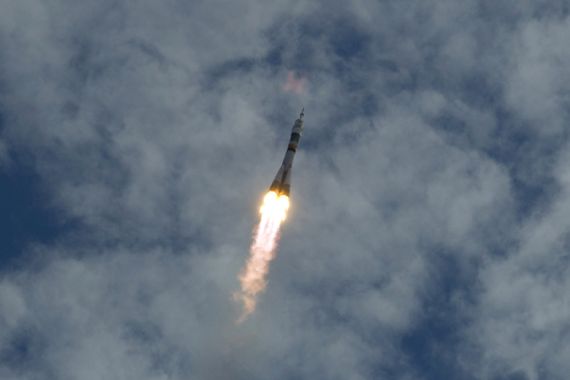Soyuz rocket launches new crew to space
Rocket blasts off from Kazakhstan on a mission to space station with crew including Russian, US and Japanese astronauts.

A Russian Soyuz craft have launched into the skies over Kazakhstan, carrying three astronauts to the international space station where they will quickly start preparing for a flurry of incoming traffic.
Russian cosmonaut Yuri Malenchenko, NASA astronaut Sunita Williams and Japanese astronaut Akihiko Hoshide boarded Sunday the Soyuz TMA-05M rocket for a four-month mission on the International Space Station (ISS) that Moscow hopes will help restore confidence in its space programme.
Keep reading
list of 4 itemsWorld’s coral reefs face global bleaching crisis
Why is Germany maintaining economic ties with China?
Australia’s Great Barrier Reef suffers worst bleaching on record
“The Soyuz had a very smooth ride into space,” a spokesperson for NASA said during a live broadcast on the agency’s television channel. The rocket blazed a bright orange trail through cloudy skies above the Kazakh steppe.
“The most tense, the most difficult part [of the launch] has been successfully implemented,” said Vladimir Popovkin, head of Russian space agency Roscosmos.
“I have just spoken to the crew. They are feeling great,” Russian news agencies quoted Popovkin as saying in Baikonur. “I have no doubts that all will go according to plan.”
Malenchenko, a 50-year-old cosmonaut on his fifth space voyage, loosened his straps about 20 minutes after blast-off after conducting air pressure checks.
Successful launch
Asked by Mission Control how the crew was feeling, he responded that they were “good”. A doll given to Malenchenko by his daughter dangled from the roof of the capsule.
Williams and Hoshide are both on their second space flight and their first aboard a Soyuz spacecraft. They, along with Malenchenko, are scheduled to return to Earth in mid-November.
They are scheduled to dock early on Tuesday, joining NASA Flight Engineer Joseph Acaba and Russian cosmonauts Gennady Padalka and Sergei Revin aboard the ISS, a $100bn research complex orbiting 385km above Earth.
Since the retirement of the space shuttles last year, the United States is dependent on Russia to fly astronauts to the ISS, which costs the nation $60mn per person.
Moscow hopes a successful mission will help to restore confidence in its once-pioneering space programme after a string of launch mishaps last year, including the failure of a mission to return samples from the Martian moon Phobos.
The previous Soyuz launch on May 15 was delayed by more than one month to allow Russia’s partly state-owned space contractor, RKK Energia, to prepare a new capsule for launch after an accident during pressure tests damaged the Soyuz crew capsule.
Sunday’s launch took place less than three weeks after China’s Shenzhou 9 spacecraft returned to Earth, ending a mission that put the country’s first woman in space.
Although China is far from catching up with the United States and Russia, the Shenzhou 9 marked China’s fourth manned space mission since 2003 and comes as budget restraints and shifting priorities have held back US manned space launches.
The space station is being prepared for an unprecedented level of traffic. Japan’s HTV3 cargo ship will dock with the space station next week, the first of nine craft making contact with the orbiting satellite over a 17-day span.